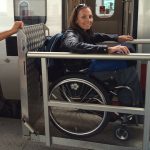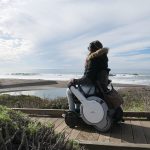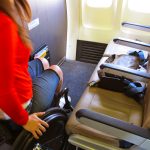Dear President Peevey and Commissioners:
Uber and Lyft have admitted that they have no wheelchair accessible vehicles in their networks (at least in San Francisco) and have no plans to obtain or provide any. I attended the July 18, 2014, meeting of the San Francisco Mayor’s Disability Council (MDC), at which a representative of Uber admitted this, and the September 19, 2014, MDC meeting, at which a representative of Lyft made the same admission. The Lyft representative described her company’s efforts to recruit drivers of wheelchair accessible vehicles. These efforts revealed a naïveté and lack of knowledge about wheelchair access and about the lives and logistical difficulties of people who use wheelchairs. Both companies’ representatives maintained the fiction that they merely provide information technology to facilitate a “peer” matching service but don’t provide transportation. This despite the fact that the TNCs process payments, many drivers drive for them full-time, and some of the TNCs recruit drivers by offering a guaranteed minimum income for an initial period and offering to finance the purchase of vehicles.
[These comments are submitted to the California Public Utilities Commission en banc meeting of November 4, 2014 about Transportation Network Companies (TNCs). I’ve lived in San Francisco since 1982 and have used an electric wheelchair since 1990. I urge you not to the TNCs to continue to discriminate against wheelchair users, and, instead, to require them to directly provide wheelchair accessible service.]
Before the advent and dominance of the TNCs, the system of wheelchair accessible taxis in San Francisco wasn’t ideal, but it functioned. In the past couple of years, however, I have essentially stopped trying to get accessible taxis except to and from the airport. For many years, even for rides to the airport, I’ve called a superb rampvan driver with whom I’m friends. If he was unavailable, I had a list of other rampvan drivers, and called them. (I’d found it more reliable and convenient to call rampvan drivers directly than to call the taxi companies.) But in the past couple of years, if my friend is unavailable, he has been unable to refer me to anyone else. Most of the drivers on his and my lists no longer drive taxis, and those few who do, no longer drive rampvans.
My most recent trip to SFO was in May of this year. My friend the rampvan driver was out of town, and he was literally unable to find anyone else to provide an accessible taxi ride to the airport. Fortunately I got a ride from a family member who was able to rearrange her schedule. Upon landing at SFO in early June, I was able to find a rampvan easily for a ride home.
SFO signed agreements in October 2014 with Uber, Sidecar and Lyft, allowing them to operate at the airport. This may well be the death knell for accessible taxis at SFO. Did SFO, as a condition of permitting them to operate at the airport, require the TNCs to provide wheelchair accessible transportation? If it didn’t, it not only undermined the system of accessible taxis, missed an opportunity to create a more accessible transportation system, and squandered the negotiating leverage it had, but it sent the TNCs – and the disability community – a clear message that it’s okay for the TNCs to discriminate against consumers in wheelchairs.
At one of the MDC meetings mentioned above, a representative of Luxor Cab mentioned that a few years ago Luxor had 40 rampvans in its fleet, now (at the date of the meeting) only 20 in the fleet, and only 10 are in service at any time. According to an article in the San Francisco Chronicle, the number of pickups in rampvans dropped from 1,378 in March 2013 to just 768 in July 2014. (The article doesn’t say whether all of those passengers were wheelchair users or the number includes able-bodied passengers.) (“Ride Services Decimate SF Taxi Industry’s Business,” San Francisco Chronicle, September 16, 2014.) SFMTA is providing financial incentives for taxi drivers to drive rampvans and pick up passengers in wheelchairs, but they are not working. In November 2012 a friend who uses a scooter was visiting. He was staying at the Marriott downtown and was going to meet me at the Asian Art Museum. In the middle of the day on a clear, sunny weekday, not during rush hour, he had to wait literally one hour to get a rampvan from his hotel, even though the hotel called several taxi companies multiple times.
There is a downward spiral. As fewer ramp taxis are in service, wait times increase and reliability decreases, consumers in wheelchairs like me give up trying to use them, which makes business worse and increases the per-trip and per-mile costs of operating accessible taxis. More drivers stop driving ramp taxis.
Buses and paratransit are not the equivalent of taxis. For decades only taxis, and now also TNCs, provide on-demand, door-to-door, non-shared transportation. As TNCs come to supplant the taxi system, they, too, should be required to provide equivalent transportation to people who use wheelchairs, as the taxi industry has been required to do in San Francisco for decades.
Some have suggested that the TNCs be required to collect a surcharge on every ride, with the money being used to subsidize wheelchair accessible taxis. Seattle is reported to be considering this. This is wrong and unlikely to work in the long run. The TNCs maintain that they have no obligation – moral, legal or otherwise – to provide wheelchair accessible transportation. In effect, they maintain that they have the right to discriminate against wheelchair users. (Their position is similar to that of private clubs that rented hotel rooms to nonmembers and claimed that the civil rights laws didn’t apply to them because they are private clubs. The clubs were wrong, and so are the TNCs.) Letting them off with a surcharge would be an acceptance of this position. It would also set a bad precedent for the so-called “sharing economy” in general.
Letting the TNCs merely collect a surcharge would foster a separate, unequal and inferior system of on-demand transportation for wheelchair users. The financial incentives San Francisco MTA is currently providing for rampvan taxis aren’t working. What reason is there to believe that funding additional incentives by means of a small surcharge on TNC rides would work? And if the TNCs’ obligations were limited to collecting and remitting a surcharge, they would have no involvement, and no incentive ever to become involved, in running the system – call it taxis or something else – of wheelchair accessible on-demand transportation. The segment of the on-demand transportation industry that is the largest, fastest growing, best financed, most sophisticated in advertising, marketing and lobbying, and most technologically savvy would not be involved in the system that provides wheelchair accessible transportation. That is a recipe for an underfunded, poorly functioning, second-class system.
Even if it did work for a while, how long would such a system survive? Nobody can predict what will happen to the taxi industry in a few years, and whether it will even continue to exist. If the TNCs’ business strategy succeeds, there will be no taxis. But having initially allowed the TNCs to avoid providing wheelchair accessible transportation, state and local regulators will hardly be in a position to change course and try to impose such a requirement some years later. It will be too late.
The only fair and viable solution is to have strong state and local regulation requiring the TNCs to provide wheelchair accessible transportation at the same level of service as the regular transportation they provide. This would mean declaring that the Emperor has no clothes – that the TNCs are actually in the business of providing transportation. But regulators are already doing this in imposing insurance requirements, driver background checks and other consumer protections. The TNCs are accepting some regulations while still publicly maintaining the fiction that they don’t provide transportation. Except in the aggressive, sophisticated and high-priced public relations campaigns of the TNCs, this fiction is receding in the face of reality. Just as San Francisco has required the taxi industry to provide wheelchair accessible transportation, among other regulatory requirements, the CPUC and SFMTA should do so with respect to TNCs.
It is relevant to note that, as they have done with TNCs, San Francisco government has taken a hands-off approach to accessibility of limousine/private car services and sightseeing buses, declining to assert regulatory jurisdiction or even to use San Francisco’s considerable financial, logistical and practical leverage to require access.
This summer I tried to arrange, with a limousine/private car service, an accessible short ride within San Francisco that would have been less than $10 in a taxi or TNC, for an acquaintance from out of town, a Grammy award-winning pianist who uses a wheelchair. I called Bauer and Gateway, the two largest providers in San Francisco. The smallest accessible vehicle Bauer could provide was a 24-seater, at a cost of $616 for four hours (there is a four-hour minimum). Gateway could only provide a “minibus” at $131 per hour with a three-hour minimum. Neither the Bauer nor the Gateway employees were knowledgeable about access; they noted my request and said they would call me a day or two later. Neither called, so I had to chase them. Besides the outrageous prices, it was obvious that neither company was interested in providing accessible transportation. Ultimately I didn’t book with either one.
A significant percentage of the hop-on hop-off and other sightseeing buses operating in San Francisco are not wheelchair accessible. I see inaccessible ones often, including when I roll past a large dedicated parking space on Fell near Pierce streets that San Francisco government has provided the tour bus operators. Some bus drivers have confirmed to me that their vehicles aren’t accessible.
When I inquired about these discriminatory situations, San Francisco City employees told me they believe that the CPUC, and not the City and County of San Francisco, has jurisdiction over limousine/private car services and sightseeing buses.
Please do not bestow the blessing of the California Public Utilities Commission on yet another transportation system that is inaccessible to consumers who use wheelchairs, especially one that is rapidly becoming dominant and ubiquitous, and that may make taxis obsolete. Require the TNCs to directly provide wheelchair accessible transportation at a level equivalent to that enjoyed by their other customers.
Thank you for considering these comments.
Sincerely,
Howard L. Chabner













